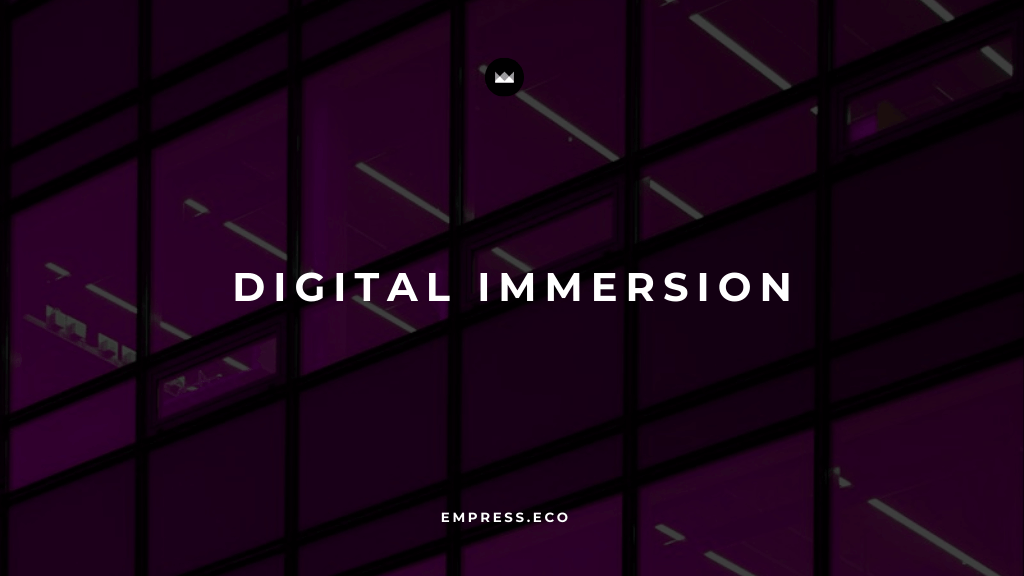
Immersive Brand Design for the Digital Age: DADA’s Leading Solutions
How AR, VR, and sensory engagement are redefining how brands connect with audiences.
Table of Contents
As technology continues to advance, the way brands engage with their audiences is undergoing a significant transformation. Immersive design, powered by augmented reality (AR), virtual reality (VR), and sensory engagement, is redefining brand experiences, making them more interactive, memorable, and impactful. This blog explores how these technologies are shaping the future of brand experience and provides insights into leveraging them effectively.
Understanding Immersive Design
Immersive design involves creating brand experiences that engage multiple senses, often through the integration of AR, VR, and other sensory technologies. These experiences blur the lines between the physical and digital worlds, allowing brands to connect with consumers in more dynamic and meaningful ways. By engaging sight, sound, touch, and even smell, immersive design creates a rich, multi-dimensional experience that captivates audiences and enhances brand perception.
What is AR and VR?
Augmented Reality (AR) overlays digital content onto the real world, enhancing the user's perception and interaction with their environment. Virtual Reality (VR), on the other hand, immerses users in a completely virtual environment, replacing the real world with a simulated one. Both technologies offer unique opportunities for brands to create compelling and engaging experiences.
Benefits of Immersive Design for Brands
Enhanced Engagement and Interaction
Immersive technologies invite consumers to actively participate in brand experiences. By engaging multiple senses, brands can create deeper emotional connections and foster greater engagement, turning passive observers into active participants. For example, an AR app that allows users to visualize furniture in their home not only engages them visually but also involves them in the decision-making process, making the experience more personal and impactful.
Improved Brand Differentiation
In a crowded market, immersive design helps brands stand out by offering unique and memorable experiences. By leveraging AR and VR, brands can create distinctive narratives that differentiate them from competitors. Imagine a car company using VR to offer virtual test drives, allowing potential customers to experience the thrill of driving their latest model from the comfort of their own home. Such experiences are not only memorable but also set the brand apart from others offering more traditional marketing approaches.
Increased Customer Loyalty and Advocacy
Immersive experiences that resonate with consumers can lead to stronger brand loyalty and advocacy. When consumers feel emotionally connected to a brand, they are more likely to become repeat customers and recommend the brand to others. A well-crafted VR experience that tells a compelling story about a brand's commitment to sustainability, for example, can leave a lasting impression and foster a loyal customer base that shares the brand's values and mission.
Enhanced Product Visualization and Understanding
AR and VR technologies allow consumers to visualize products in real-world contexts, improving their understanding and confidence in purchasing decisions. This "try before you buy" capability reduces hesitation and enhances the shopping experience. For instance, an AR app that lets users see how a piece of clothing will look on them before making a purchase can significantly boost their confidence and reduce return rates.
Key Strategies for Implementing Immersive Design
Leveraging AR for Interactive Product Experiences
AR technology can transform how consumers interact with products. Brands can use AR to create interactive product showcases, allowing customers to visualize products in their own spaces before purchasing. This enhances the online shopping experience and helps consumers make informed decisions.
Examples of AR Applications:
- IKEA Place App: Allows users to visualize furniture in their homes using AR.
- Sephora Virtual Artist: Lets customers try on makeup virtually through AR.
By integrating AR into their marketing strategies, brands can offer personalized and engaging experiences that cater to the individual needs and preferences of their customers. This not only enhances customer satisfaction but also drives sales and fosters brand loyalty.
Creating Virtual Reality Showrooms and Events
VR technology enables brands to create immersive virtual showrooms and events that consumers can explore from anywhere. This approach is particularly effective for industries like automotive and real estate, where spatial context is important.
Examples of VR Applications:
- Virtual Car Showrooms: Allow customers to explore car models in a virtual environment.
- Virtual Product Launches: Enable global audiences to participate in product unveilings.
Virtual showrooms offer a unique opportunity for brands to showcase their products in an interactive and engaging way. By allowing customers to explore products in a virtual environment, brands can provide a richer and more detailed experience that goes beyond what traditional marketing methods can achieve. Additionally, virtual events can reach a global audience, breaking down geographical barriers and increasing brand exposure.
Enhancing Sensory Engagement
Immersive design goes beyond visual and auditory elements by incorporating other senses, such as touch and smell. Brands can create multi-sensory experiences that leave lasting impressions and deepen emotional connections.
Examples of Sensory Engagement:
- Haptic Feedback: Provides tactile sensations in digital environments.
- Scent Marketing: Uses fragrances to evoke emotions and memories.
By engaging multiple senses, brands can create more immersive and memorable experiences. For example, a virtual reality experience that includes haptic feedback can make users feel as if they are physically interacting with the virtual environment. Similarly, scent marketing can enhance the atmosphere of a physical store or event, making it more inviting and memorable.
Crafting Immersive Storytelling
AR and VR offer unparalleled opportunities for immersive storytelling. Brands can create interactive narratives that captivate audiences and convey their values and messages in engaging ways.
Examples of Immersive Storytelling:
- Interactive Narratives: Allow users to influence the story through their choices.
- Branded Virtual Worlds: Create fully realized environments for users to explore.
Immersive storytelling allows brands to create deeper emotional connections with their audience. By involving users in the narrative and giving them control over the outcome, brands can create more engaging and personalized experiences. This not only enhances user engagement but also helps to convey brand values and messages in a more impactful way.
Overcoming Challenges in Immersive Design
Balancing Technology and Creativity
While technology offers new possibilities, it's essential to maintain a balance between innovation and creativity. Focus on storytelling and user experience, using technology as a tool to enhance, not overshadow, the narrative.
Brands should avoid relying solely on technology for the sake of innovation. Instead, they should focus on creating meaningful and engaging experiences that resonate with their audience. By prioritizing storytelling and user experience, brands can use technology to enhance their narratives and create more impactful experiences.
Ensuring Accessibility and Inclusivity
Immersive experiences should be accessible to diverse audiences. Consider factors like device compatibility, user interface design, and inclusive content to ensure everyone can participate.
Brands should ensure that their immersive experiences are accessible to as many people as possible. This includes considering factors such as device compatibility, user interface design, and content inclusivity. By making their experiences accessible and inclusive, brands can reach a wider audience and foster greater engagement and loyalty.
Measuring Impact and ROI
Evaluating the success of immersive experiences requires clear metrics and objectives. Track engagement, conversion rates, and customer feedback to assess the impact and refine your strategies.
To measure the success of their immersive experiences, brands should set clear metrics and objectives. This includes tracking engagement, conversion rates, and customer feedback. By analyzing these metrics, brands can assess the impact of their immersive experiences and refine their strategies to achieve better results.
The Future of Immersive Design
The future of brand experience lies in immersive design, where AR, VR, and sensory engagement redefine how brands connect with audiences. As these technologies continue to evolve, brands will have even more opportunities to create engaging, memorable, and impactful experiences.
Emerging Trends in Immersive Design
- Mixed Reality (MR): Combining AR and VR to create even more immersive experiences.
- 5G Technology: Enhancing the capabilities of AR and VR with faster and more reliable connections.
- AI Integration: Using artificial intelligence to create more personalized and interactive experiences.
Mixed Reality (MR)
Mixed Reality (MR) combines elements of both AR and VR to create even more immersive experiences. By blending the physical and digital worlds, MR allows users to interact with virtual objects in real-time, creating a seamless and integrated experience.
Examples of MR Applications:
- Microsoft HoloLens: A mixed reality headset that allows users to interact with holograms in their physical environment.
- Magic Leap: A mixed reality device that combines digital content with the real world.
5G Technology
The advent of 5G technology is set to revolutionize the capabilities of AR and VR. With faster and more reliable connections, 5G will enable more seamless and interactive immersive experiences. This will open up new possibilities for brands to engage with their audiences in real-time.
Examples of 5G Applications:
- Real-Time AR Experiences: Faster connections allow for more responsive and interactive AR experiences.
- Enhanced VR Streaming: Higher bandwidth enables higher quality and more immersive VR streaming.
AI Integration
Artificial Intelligence (AI) is set to play a significant role in the future of immersive design. By integrating AI with AR and VR, brands can create more personalized and interactive experiences. AI can analyze user behavior and preferences to deliver tailored content and experiences.
Examples of AI Integration:
- Personalized VR Experiences: AI analyzes user preferences to create customized VR experiences.
- Interactive AI Characters: AI-driven characters that interact with users in real-time.
Conclusion
The future of brand experience lies in immersive design, where AR, VR, and sensory engagement redefine how brands connect with audiences. By leveraging these technologies, brands can create engaging, memorable, and impactful experiences that resonate with consumers on a deeper level.
As the digital landscape evolves, embracing immersive design will be crucial for brands seeking to differentiate themselves and build lasting relationships with their audiences. Start exploring the possibilities of AR, VR, and sensory engagement today to elevate your brand experience and connect with your audience like never before. By focusing on storytelling, user experience, and inclusivity, brands can harness the power of immersive design to create truly transformative experiences.
Empress Newsletter
Join the newsletter to receive the latest updates in your inbox.







